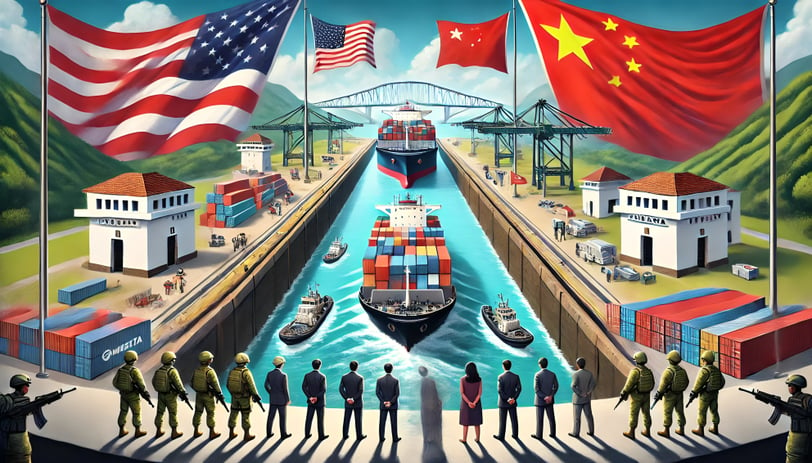Is Panama Canal Issue a Part of the Larger Trade War Between the U.S. and China?
China in recent years has expanded its free trade collaborations with South American countries, and the U.S. looks at the increasing diplomatic and trade influence of China in the region as a threat.
EXPERT ANALYSIS
GeopoliticsTv Team
2/3/20254 min read


The Panama Canal is among the most crucial waterways that plays the most significant roles in the everyday life of the world. A huge of world trades pass through this important waterway.
The Panama Canal is in news again, and the world curiously looks at the unfolding of events centered around the Canal.
On Sunday, U.S. Secretary of State Mr. Marco Rubio visited Panama and held meeting with Panama President Jose Raul Mulino. As promised by the U.S. President Donald Trump during his presidential campaign, his Secretary of State asked Panama President to end China's influence over the Canal or face U.S. action. Rubio warned that if Panama did not take the necessary measures to end Chinese influence over the Canal, the U.S. would be pressed to act.
Panama President, after the talks, agreed to review the agreements on the Panama Canal. Panama also has agreed to give free passage to the U.S. warships through the canal.
Why is Panama Canal so Crucial that the U.S. wants its rivals away?
According to U.S. President Donald Trump, China is in the control of the Panama Canal, and the U.S. wants the canal to be a neutral place, with no political or military control.
According to the U.S. China has a presence at the Canal through a Hong-Kong based company that operates two ports near the canal’s entrance—which Trump sees as a threat.
The Canal Itself
The Panama Canal is an artificially constructed waterway, 51 miles in length, that connects Atlantic Ocean with the Pacific Ocean.
It is a link between North and South America. It creates a shortcut that ensures vessels do not have to travel around Cape Horn, saving them significant time and money.
Among the commodities carried through the canal are motor vehicles, petroleum products, grains, and coal and coke.
The Canal was constructed hugely by United States of America and opened in 1914. It went back to Panama for day-to-day operations after a treaty of neutrality was signed by President Jimmy Carter in 1977.
Today, the Panama Canal is the fifth busiest waterway, the English Channel being the busiest of the waterways of the world.
While the English Channel manages the passage of around 500 ships a day, the Panama Canal allows around 15,000 ships a year.
The English Channel is a crucial link between Europe and the rest of the world as it connects the North Sea to the Atlantic.
Other Busy Shipping Routes important for international trades
The Malacca Strait
The other crucial shipping route for world trades is the Malacca Strait—the second most busy. It is a narrow waterway between Malay Peninsula and the Indonesian island of Sumatra. It handles 25% of the internationally traded goods, and about 96,000 vessels annually.
The Strait of Hormuz
The Strait of Hormuz is the third of world’s busiest trade routes, is a small canal near the mouth of the Persian Gulf that connects Iran and Oman from the Persian Gulf to the open ocean. Major shipment through this Straight includes oil—about 30% of world’s seaborne oil, around 21 million barrels passing daily.
The Suez Canal
The Suez Canal is the world's fourth busiest shipping trade route. It is an artificial waterway that connects Mediterranean Sea to the Red Sea. Over 20,000 vessels pass through the waterway annually. Cargo includes grain, coal, and other raw materials.
Coming Back to Panama Canal
Panama Canal is a link between North and South America, situated right under the nose of the United States of America, and Trump would not like to see any competition here in terms of exercising direct or indirect control in the canal’s operation. Trump has been accusing China of controlling the operation of Panama Canal.
How much is Trump true on his statement of China controlling Panama Canal?
There are a total of five ports on either side of the canal, two of which are owned by a Hong-Kong based conglomerate CK Hutchison Holdings, owned by billionaire Li Ka-shing—one Balboa port on the Pacific side, and the other is Cristobal port on the Atlantic side. The ports are not owned by the company—named for the operation as “Panama Port Company”—but operated on behalf of the government of Panama as per an agreement. In 2021, the lease to Panama Port Company had been extended by 25 years.
U.S. was one of the top Users of the Canal
The United States of America has been one of the top users of Panama Canal. Other countries hugely using the canal include China, Chile, Japan and South Korea. The waterway connects a total of 180 maritime routes linking 1,920 ports across 170 countries.
China trade Expansion in Latin America
China in recent years has expanded its free trade collaborations with South American countries. The nations include Chile, Peru, Ecuador, Nicaragua, Costa Rica among others, increasing its influence over the region.
China has clarified that it does not participate in the day-to-day operations of the Panama Canal and has never interfered in the affairs of the canal.
The U.S. however, looks at the increasing diplomatic and trade influence of China in the region as a threat, which the U.S. clearly wants to limit.
What next?
The Panama Canal issue could be perceived as an extension of the U.S. strategy to diplomatically and economically limit China in the region. As of now, Trump appears to achieved a score by convincing Panama to revisit its operations of the canal and allow free passage to U.S. warships.
However, unfolding of events around Panama Canal vis-à-vis trade war between the two largest economies of the world would continue to be an important thing to watch out in the coming days.
